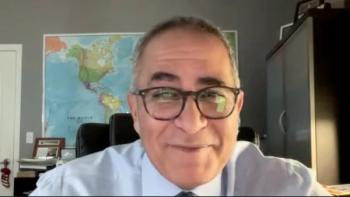
- ONCOLOGY® Companion, Volume 39, Supplement 7
- Issue 7
- Pages: 18-19
Long-Term Cilta-Cel Follow-Up Shows Curative Potential in Pretreated Multiple Myeloma
Cilta-cel shows promising long-term efficacy in treating relapsed/refractory multiple myeloma, with significant survival rates and manageable safety profiles.
Long-term follow-up results from the phase 1b/2 CARTITUDE-1 trial (NCT03548207) showed that ciltacabtagene autoleucel (cilta-cel; Carvykti) remained efficacious and that it may be curative in relapsed/refractory multiple myeloma. Peter Voorhees, MD, a professor of cancer medicine at Wake Forest University School of Medicine; and Sundar Jagannath, MBBS, a professor of medicine at Icahn School of Medicine at Mount Sinai and The Tisch Cancer Institute, discussed these most recent results shared at the European Hematology Association (EHA) 2025 Congress as part of a Between the Lines® program hosted by CancerNetwork.1
According to Jagannath, an array of agents has been approved for multiple myeloma treatment, ranging from bortezomib
(Velcade) and lenalidomide (Revlimid) in 2003 and 2006 to talquetamab-tgvs (Talvey) and elranatamab (Elrexfio) in 2023. Amid all these agents, cilta-cel is one of 2 chimeric antigen receptor (CAR) T-cell therapies approved and has shown promising and exciting benefits to patients with multiple myeloma, particularly long-term.
As Jagannath said, “Once we found out [cilta-cel] was inducing complete remission in [patients with] relapsed/refractory [disease], the study was designed for accelerated approval.”
CARTITUDE-1 Trial Breakdown
CARTITUDE-1 enrolled 97 patients between the trial’s phase 1b and 2 stages. The patient population was fit, with an ECOG performance status of 1 or less, and heavily pretreated, with at least 3 prior therapies or double-refractory disease being a requirement. All patients were exposed to what Voorhees called the “3 core pillars of therapeutics in the multiple myeloma space”: a proteasome inhibitor, an immunomodulatory drug, and an anti-CD38 antibody.
Patients underwent leukapheresis for CAR T-cell therapy manufacturing, bridging therapy to control their disease, if necessary, and lymphodepletion chemotherapy—cyclophosphamide at 300 mg/m2 plus fludarabine at 30 mg/m2—for 3 days. After this, a single cilta-cel infusion was administered at a target of 0.75 × 106 cells per kg.
Follow-up did occur in CARTITUDE-1; however, for longer-term follow-up, all the patients who were alive were approached to consent to be in the phase 4 “CARTinue” study (NCT05201781), as Voorhees and Jagannath called it, which had a 15-year follow-up period for these patients.
The median number of prior lines of therapy was 6 (range, 3-18); 87.6% of patients were triple-class refractory, and 99.0% were refractory to the last line of therapy. “They were a really refractory population, and the good news was that this drug was effective,” said Jagannath.
Efficacy
With a median follow-up of 33.4 months (range, 1.5-45.2), the median progression-free survival (PFS) in all 97 patients who received cilta-cel was 34.9 months (95% CI, 25.2-not estimable [NE]), with 30- and 36-month PFS rates of 54.2% and 47.5%, respectively.2 Voorhees compared these PFS data with what was seen in the observational LocoMMotion trial (NCT04035226), which was designed to assess what would occur in a patient population eligible for CARTITUDE-1 who did not receive cilta-cel. The median PFS from LocoMMotion was 4.6 months. According to Voorhees, the advantage in CARTITUDE-1 is “unbelievable.”
Further, in the 76 patients who achieved a complete response (CR) or greater, the median PFS was 38.2 months (95% CI, 34.9-NE), with 30- and 36-month PFS rates of 66.8% and 59.8%. In the 34 patients who achieved minimal residual disease (MRD) negativity for 6 months, the median PFS was 32.2 months (95% CI, 25.1-NE), with 30- and 36-month PFS rates of 68.6% and 45.7%. For the 26 patients who sustained MRD negativity at 12 months and the 20 patients who sustained it at 12 months with a CR, the median PFS was not reached (NR; 95% CI, NE-NE) for both, with 30-month PFS rates of 74.9% and 78.5%, respectively, and 36-month PFS rates of NE for both.
“[This] speaks to the fact that deep MRD-negative remissions that are sustained translate into good, long-term outcomes,” added Voorhees.
Jagannath also mentioned that the overall response rate was approximately 98%, with only 1 or 2 patients not responding to cilta-cel, and approximately three-fourths of responses being CRs.
In the updated data from the EHA 2025 Congress, at a median follow-up of 61.3 months, 33% of patients (n = 32/97) were treatment and progression free at 5 years and beyond; the median overall survival was 60.7 months (95% CI, 41.9-NE). “In this late line of patients, this is the first ever trial to have long-term median follow-up of 5-year results reported,” stated Jagannath.
Jagannath and Voorhees also emphasized the importance of CARTinue data and that the FDA and the European Medicines Agency wanted to see if there were long-term complications from cilta-cel. This also resulted in a follow-up period of 5 years, which ultimately showed that 30% of patients remained progression free.
Safety
Common any-grade and grade 3/4 adverse events (AEs) from the study included neutropenia (95.9% and 94.8%, respectively), anemia (81.4% and 68.0%), and thrombocytopenia (79.4% and 59.8%). Other significant AEs were fatigue (37.1% and 5.2%, respectively), cough (35.1% and 0%), hypocalcemia (32.0% and 3.1%), and hypophosphatemia (30.9% and 7.2%). Any-grade and grade 3/4 cytokine release syndrome (CRS) occurred in 94.8% and 4.1% of patients, respectively, with a median time to onset of 7 days (range, 1-12). Neurotoxicity occurred in 20.6% and 9.3% of patients, with immune effector cell–associated neurotoxicity syndrome (ICANS) occurring in 16.5% and other neurological AEs in 12.4%.
Deaths due to treatment-related AEs, progressive disease, and AEs unrelated to treatment occurred in 6, 5, and 3 patients, respectively.
Additionally, no new CRS events had occurred at the long-term follow-up, with no changes in the incidence, time to onset, or duration. The data showed signs and symptoms of parkinsonism in 1 patient and 20 secondary primary malignancies unrelated to cilta-cel in 16 patients. Thirty deaths had occurred.
When prompted about the delayed neurotoxicity, such as parkinsonism, observed in the trial, Jagannath noted that it primarily occurred in patients with high exponential multiplication of the CAR T-cells in those with high tumor burden. For the patients with improved tumor cytoreduction—those who went into bridging chemotherapy—the parkinsonism did not persist; the expansion of the T cells was beneficial. Patients also experience cranial nerve palsy, or peripheral neuropathy, which develops at the end of 1 month and then resolves spontaneously. Although it is difficult to pinpoint why the CAR T-cells occlude that area, Jagannath added that it is at least “reversible.”
“[Cilta-cel] is fairly well tolerated in this advanced patient population, and when you do this kind of treatment in late stage, the patient has a lot of treatment burden and effect on their body. The kidney function is not optimal, and [there’s] some lingering toxicity and things like that, so considering all that, this has proved to be a very safe treatment modality,” said Jagannath.
Post Hoc Analysis
Following the 5-year follow-up, investigators conducted a post hoc analysis to evaluate the 32 patients who remained free of progression at 5 years and beyond compared with those who had relapsed within the 5 years.
Regarding patient demographics, both groups were evenly matched. What surprised Jagannath, however, was the equal distribution of extramedullary disease. “I was totally shocked to find out [that] the [patients with] high-risk disease and [those with] extramedullary disease were equally distributed,” he said.
The analysis did provide several indicators, one of which was a tendency for a lower tumor burden in the patients who had long-term remission; this included a lower percentage of median plasma cells in the bone marrow and a lower soluble BCMA level, which showed that the lower tumor burden was a positive aspect.
Additionally, the patients with more CAR-positive naive T cells, those with a robust expansion of CAR-positive T cells, and those with CAR-positive, CD4-positive T cells with a central memory phenotype did better in the long-term.
Speaking about these patient groups, Jagannath said, “If I use this CAR T cell earlier in the [treatment] of this patient, they will have a fitter immune system. They will have better T cells in circulation. There will be more naive T cells. The tumor burden would have been easier to control, or they would have already been in a lower tumor burden phase. Looking at that, using cilta-cel earlier in the lines would result in a better outcome.”
References
- Jagannath S, Martin TG, Lin Y, et al. Long-term (≥5 year) remission and survival after treatment with ciltacabtagene autoleucel in CARTITUDE-1 patients with relapsed/refractory multiple myeloma. J Clin Oncol. Published online June 3, 2025. doi:10.1200/JCO-25-0076
- Lin JJ, Drilon AE, Cho BC, et al. Intracranial and systemic efficacy of repotrectinib in advanced ROS1 fusion-positive (ROS1+) non-small cell lung cancer (NSCLC) and central nervous system metastases (CNS mets) in the phase 1/2 TRIDENT-1. J Clin Oncol. 2025;41(suppl 16):9017. doi:10.1200/JCO.2023.41.16_suppl.9017
Newsletter
Stay up to date on recent advances in the multidisciplinary approach to cancer.


![“[This approval] will be a quite dramatic change in our philosophy and practice in multiple myeloma," according to Joseph Mikhael, MD, MEd, FRCPC, FACP, FASCO.](https://cdn.sanity.io/images/0vv8moc6/cancernetwork/3cab3ada4c023b68c118240a512e31d72a7f931b-1200x628.png?w=350&fit=crop&auto=format)













































































